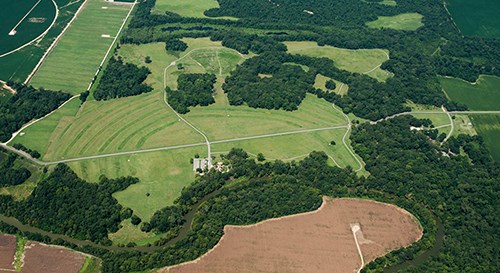Last updated: July 23, 2020
Article
Monumental Earthworks of Poverty Point: World Heritage Site

Monumental Earthworks of Poverty Point is located in the Lower Mississippi Valley on a slightly elevated and narrow landform. Located on more than 400 acres, it is a series of earthen mounds and ridges that overlook the Mississippi River flood plain in what is now northeastern Louisiana. It was created and used for residential and ceremonial purposes by a society of hunter fisher-gatherers between 1700 and 1100 B.C.E., and is a remarkable achievement in earthen construction in North America that was unsurpassed for at least 2,000 years. At its peak 3,000 years ago it was part of an enormous trading network that stretched for hundreds of miles across the continent.
Poverty Point is a National Monument, operated by the State of Louisiana as a state park. Unlike some other sites that have been altered and tremendously disturbed by modern projects and excavations, it is estimated that less than 1 percent of the site has been disturbed. Its name comes from a 19th-century plantation that was nearby.
An apparently large, sophisticated society constructed the impressive complex -- an engineering feat comprised of five mounds, six concentric semi-elliptical ridges separated by shallow depressions and a central plaza. While researchers and archeologists have been unable to decipher the reasons behind the structure and design of Poverty Point, researchers have estimated that around 53 million cubic feet of soil were moved to create the ridges and mounds. Archeologists, including those at the on-site archeological laboratory at Poverty Point, continue to work to discover information about the society and the reason for the construction of the mound complex. Though the population varied by season, the area was a large complex settlement that continued to have year-round occupants for over 600 years.
Relatively little is known about the Poverty Point society’s name, language or religion. Objects like clay cooking balls, spear points, and fishing tools found at the site give us some idea as to how the mound builders ate and lived. Because of the quality, diversity, and quantity of jewelry and other objects found at Poverty Point, some speculate that it may have been a capital for an entire ancient culture. The size of the complex and the number of objects are not what make Poverty Point remarkable, though. While research about the society that built Poverty Point continues, it is clear that those who moved the earth, basket by basket, were hunter-gatherers; it is unusual that such a society could build the complex system of mounds at Poverty Point.
Situated at the crossroads between the Mississippi River floodplains and Macon Ridge, the people of Poverty Point relied on fish, turtles, frogs, waterfowl, and aquatic plants. In addition to the aquatic choices, deer, small mammals, nuts, fruits, and seeds were also readily available. The area surrounding the site also provided natural resources for shelter, cooking, tool production, and warmth. The only natural resource that the people of Poverty Point relied upon, but could not find in abundance, was stone. Instead, a transportation system was created that imported several tons of rocks and minerals into the area from as far as 1,000 miles away.
Visitors have several options for exploring the earthworks. A museum at the park offers an orientation and history of the site. The museum provides visitors with opportunities to view a film at the visitor center theater and to examine artifacts discovered during excavations of the World Heritage Site. The center also features an archeological laboratory. Once oriented, visitors can take a 2.6 mile self-guided hike through the mounds and have lunch at the state park's picnic area. Guided tours are also offered.
| Monumental Earthworks of Poverty Point UNESCO Page: https://whc.unesco.org/en/list/1435/ Poverty Point Page: https://www.povertypoint.us/ |
